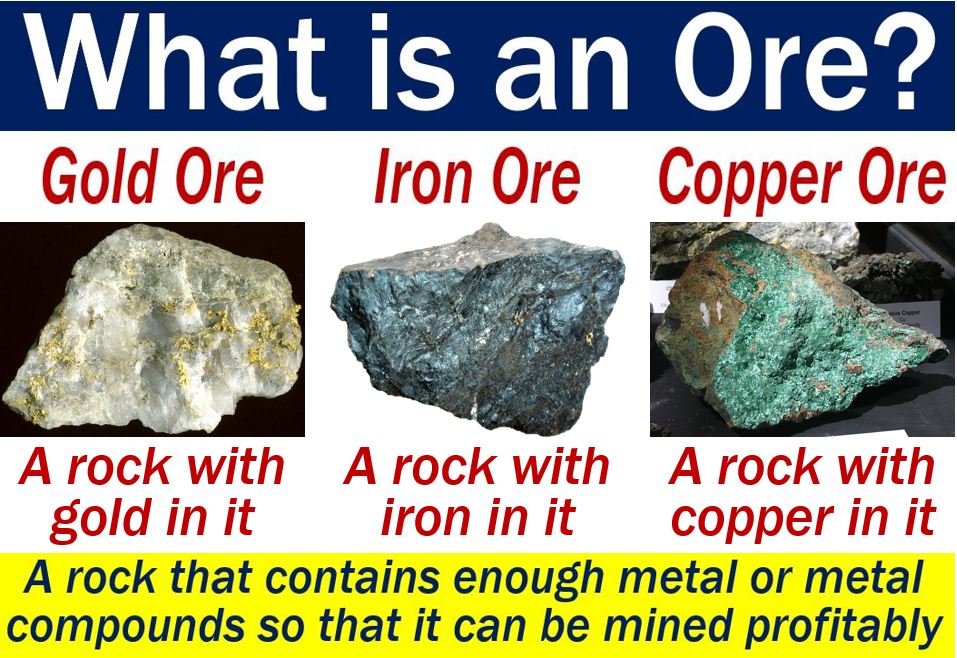Ore – definition and meaning
Ore refers to a naturally occurring rock that contains metal or metal compounds. There must be enough metal in the rock to make it worthwhile extracting. Ores are materials that we mine. They contain enough metal to justify mining on a commercial scale. In other words, we must be able to mine it at a profit.
The amount of metal that must be present for mining to be profitable depends. For example, there must be at least 20% to 30% by weight of iron to mine iron ore profitably.
However, for copper ore, we only need a 0.5% concentration of copper.
Metals linked to specific ores
Metals are sometimes associated with specific ores. Let’s have a look at some of them:
- Bauxite
For example, aluminum (British: aluminium) is found in bauxite, i.e., bauxite is an aluminum ore. We use aluminum to make medications, cosmetics, and containers.
- Hematite and..
Iron is found in hematite and magnetite ores.
- Chalcocite and..
Copper is extracted from chalcocite, chalcopyrite, and malachite ores.
- Sphalerite
Zinc is obtained from sphalerite ore.
- Galena
Lead is found in the galena ore.
- Calaverite
Gold is found primarily in its native form, meaning it’s found as pure or nearly pure nuggets. However, it can also be extracted from ores like calaverite.
- Cassiterite
Tin is extracted from cassiterite ore.
These are just a few examples. Each metal can have several different ore sources, and the ores can vary in metal content and distribution around the world.
Video – What are Ores?
According to Study.com:
“An ore is a special type of rock that contains a large enough amount of a particular mineral (usually a metal) to make it economically practical to extract that mineral from the surrounding rock.”
Metal ores are usually silicates, sulfides, oxides, or ‘native’ metals. For example, native copper is an uncombined form of copper that exists as a natural mineral.
What are ore deposits?
Deposits are accumulations of ores. We define an ore deposit as a single occurrence of a particular type of ore.
We refer to most of them according to where they are. For example, much of South Africa’s gold comes from its Witswatersrand deposit.
We sometimes name the deposit after its discoverer. For example, we name the Kambalda nickel shoots after drillers. Alternatively, we may name a deposit after a prominent person or something from mythology.

Environmental Impact of Ore Mining
Mining ores can have a significant impact on the environment. Extracting metals from their ores usually involves processes that can create environmental challenges. For instance, the extraction process can result in soil erosion, deforestation, and a loss of biodiversity.
Additionally, the chemicals used in the extraction can leach into the ground, contaminating water sources and harming aquatic life.
Large-scale mining can lead to the displacement of local communities. As mining activities expand, it can result in the removal of vegetation, altering the local landscape and impacting wildlife habitats.
On the positive side, many mining companies today are adopting sustainable mining practices. They are investing in technologies and methods that minimize environmental damage and aim to restore mined areas to their natural state. These sustainable practices not only help in conserving the environment but also improve or restore the company’s brand image, as well as its relationships with local communities.
Ore trade
Traders buy and sell ores internationally in commodity markets. In fact, metals comprise an important percentage of trade in raw materials. This is due to the unequal distribution of ores.
The London Metal Exchange is the main global hub for international trade in base metals. Base metals are metals that we do not consider as precious, i.e., they are common. For example, copper, tin, and zinc are base metals.
The COMEX and NYMEX exchanges in the US, as well as the Shanghai Futures Exchange in China, are also centers for base metal trading. However, compared to the London Metal Exchange, trade in both value and volume is quite small.
Purchasers and producers trade in iron ore through several benchmark prices. Giant mining companies and major consumers set the prices every quarter. In fact, they set the stage for smaller traders.
Many other commodities have no benchmark price. Suppliers and consumers negotiate prices each time they meet. Subsequently, determining the prices of some ores is not easy.
Examples of ‘lesser commodities’ are lithium, antimony, bismuth, niobium-tantalum, and rare earths.
China is the world’s largest importer of metals and ores, followed by the United States and Japan.

